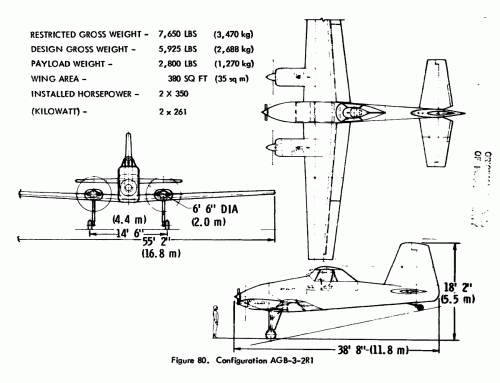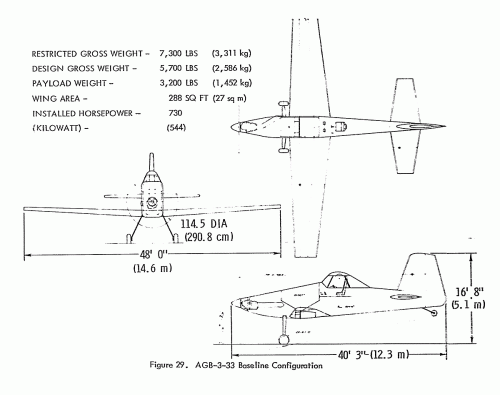You are using an out of date browser. It may not display this or other websites correctly.
You should upgrade or use an alternative browser.
You should upgrade or use an alternative browser.
NASA/Lockheed AGB-3 and AGB-7 ag-aircraft projects
- Thread starter Stargazer
- Start date
XP67_Moonbat
ACCESS: Top Secret
- Joined
- 16 January 2008
- Messages
- 2,252
- Reaction score
- 402
Re: NASA AGB-3-IFI and AGB-7-TBI ag-aircraft projects
Oh wow! That makes the X-32 look graceful.
Oh wow! That makes the X-32 look graceful.
Re: NASA AGB-3-IFI and AGB-7-TBI ag-aircraft projects
These are actually *Lockheed* designs, done under contract to NASA.
These are actually *Lockheed* designs, done under contract to NASA.
Re: NASA AGB-3-IFI and AGB-7-TBI ag-aircraft projects
For what purpose?
Orionblamblam said:These are actually *Lockheed* designs, done under contract to NASA.
For what purpose?
Re: NASA AGB-3-IFI and AGB-7-TBI ag-aircraft projects
This report contains the results of a study of advanced design requirements
for aerial application aircraft for agriculture, The study was conducted
by the Lockheed-Georgia Company under contract to the Langley Research
Center of the National Aeronautics and Space Administration. Dr. B. J.
Holmes was the NASA technical manager.
At the Lockheed-Georgia Canpany, the study was performed under the
cognizance of R. H, Lange, Manager of the Advanced Technology Systems
Department. J. T. Hinely , Jr . , served as study manager with R. Q. Boyles,
Jr., as principal investigator for system design. Piper Aircraft
Corporation and Mississippi State University participated in the program as
subcontractors.
Please to enjoy the Summary, at least as Adobe Acrobat understands it (too lazy to translate it from OCR-gibberish into English):
?he objectives of thc study wrc ko cvaluatc currcP'nt stateof-khc-art for
agricultural aircraft design, with omphaois on dcaign cotlcepts that offkr
ptcn tial for improved prduc tivity y, ccongnica , and safety; identify amas
requiring additional rcsoarch; cvnluatc air.uurt;hincss regulations; and
illustrats grunising dasiqr? ca:tccgtn. '141~ approach v,as ta develop wnveittional
baseline design configumtion~ for onc largc) aircraft and sna mlJ.
aircraft and to evaluate aircralt: ancl nuL~nysitcm tcchnalqy concepts i n canparison
with the baselines. An oyxrationc analysis nloilel was usec3 ta
obtain quantitative lrcasures of: mission prcxluc t i v i ty and econanics far the
design concepts under consideration.
This report contains the results of a study of advanced design requirements
for aerial application aircraft for agriculture, The study was conducted
by the Lockheed-Georgia Company under contract to the Langley Research
Center of the National Aeronautics and Space Administration. Dr. B. J.
Holmes was the NASA technical manager.
At the Lockheed-Georgia Canpany, the study was performed under the
cognizance of R. H, Lange, Manager of the Advanced Technology Systems
Department. J. T. Hinely , Jr . , served as study manager with R. Q. Boyles,
Jr., as principal investigator for system design. Piper Aircraft
Corporation and Mississippi State University participated in the program as
subcontractors.
Please to enjoy the Summary, at least as Adobe Acrobat understands it (too lazy to translate it from OCR-gibberish into English):
?he objectives of thc study wrc ko cvaluatc currcP'nt stateof-khc-art for
agricultural aircraft design, with omphaois on dcaign cotlcepts that offkr
ptcn tial for improved prduc tivity y, ccongnica , and safety; identify amas
requiring additional rcsoarch; cvnluatc air.uurt;hincss regulations; and
illustrats grunising dasiqr? ca:tccgtn. '141~ approach v,as ta develop wnveittional
baseline design configumtion~ for onc largc) aircraft and sna mlJ.
aircraft and to evaluate aircralt: ancl nuL~nysitcm tcchnalqy concepts i n canparison
with the baselines. An oyxrationc analysis nloilel was usec3 ta
obtain quantitative lrcasures of: mission prcxluc t i v i ty and econanics far the
design concepts under consideration.
- Joined
- 1 May 2007
- Messages
- 2,490
- Reaction score
- 1,587
Re: NASA AGB-3-IFI and AGB-7-TBI ag-aircraft projects
Found on NTRS :-
http://ntrs.nasa.gov/archive/nasa/casi.ntrs.nasa.gov/19790009677_1979009677.pdf
"Advanced System Design Requirements for Large &
Small Fixed-Wing Aerial Application Systems for Agriculture"
cheers,
Robin.
Found on NTRS :-
http://ntrs.nasa.gov/archive/nasa/casi.ntrs.nasa.gov/19790009677_1979009677.pdf
"Advanced System Design Requirements for Large &
Small Fixed-Wing Aerial Application Systems for Agriculture"
cheers,
Robin.
Machdiamond
ACCESS: Secret
- Joined
- 15 January 2007
- Messages
- 325
- Reaction score
- 28
Re: NASA AGB-3-IFI and AGB-7-TBI ag-aircraft projects
A jet propelled agplane : .
.
This reminds me the PZL M-15 Belphegor.
--Luc
A jet propelled agplane :
This reminds me the PZL M-15 Belphegor.
--Luc
- Joined
- 25 June 2009
- Messages
- 13,941
- Reaction score
- 3,574
Re: NASA AGB-3-IFI and AGB-7-TBI ag-aircraft projects
Hinely, J. T., Jr.; Boyles, R. Q., Jr. Lockheed-Georgia January 1979
Abstract
robunos said:Found on NTRS :-
http://ntrs.nasa.gov/archive/nasa/casi.ntrs.nasa.gov/19790009677_1979009677.pdf
"Advanced System Design Requirements for Large &
Small Fixed-Wing Aerial Application Systems for Agriculture"
cheers,
Robin.
Hinely, J. T., Jr.; Boyles, R. Q., Jr. Lockheed-Georgia January 1979
Abstract
Several candidate aircraft configurations were defined over the range of 1000 to 10,000 pounds payload and evaluated over a broad spectrum of agricultural missions. From these studies, baseline design points were selected at 3200 pounds payload for the small aircraft and 7500 pounds for the large aircraft. The small baseline aircraft utilizes a single turboprop powerplant while the large aircraft utilizes two turboprop powerplants. These configurations were optimized for wing loading, aspect ratio, and power loading to provide the best mission economics in representative missions. Wing loading of 20 lb/sq ft was selected for the small aircraft and 25 lb/sq ft for the large aircraft. Aspect ratio of 8 was selected for both aircraft. It was found that a 10% reduction in engine power from the original configurations provided improved mission economics for both aircraft by reducing the cost of the turboprop. Refined configurations incorporate a 675 HP engine in the small aircraft and two 688 HP engines in the large aircraft.
Tophe
ACCESS: Top Secret
Reading the AGB-7-TBI, I thought the 2x 688hp are for the engines driving big propellers while the "little propellers" are in fact aiscrews providing electric power 2x 513kW to release the ag-chemicals. All right, but... a further project mentions 2 power sources with 1 little airscrew, and I don't understand anymore ??? Has someone an explanation?
(Anyhow, I am very happy to have discovered the AGB-7-TBI, a so weird twin-boomer, so different... Thanks!) ;D
(Anyhow, I am very happy to have discovered the AGB-7-TBI, a so weird twin-boomer, so different... Thanks!) ;D
- Joined
- 26 May 2006
- Messages
- 33,049
- Reaction score
- 12,647
Attachments
Similar threads
-
-
-
Texas/Transland/Weick Ag-1 to Ag-3 series (forerunners of the Piper Pawnee)
- Started by Cy-27
- Replies: 21
-
Notional VTOL/VSTOL projects from NACA and NASA
- Started by Dronte
- Replies: 75
-
General Dynamics & Lockheed commuter aircraft projects
- Started by hesham
- Replies: 1






